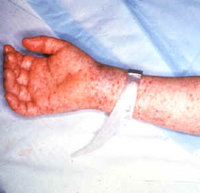In 1990, state health departments reported 649 cases of Rocky Mountain spotted fever (RMSF) to CDC, a 7.6% increase from the 603 cases reported in 1989. The incidence rate was 0.26 per 100,000 persons. Of the 649 cases, 292 (45.0%) and 101 (15.6%) were reported from the South Atlantic and the West South Central regions, respectively. Rates were highest in North Carolina (178 cases, 2.7 per 100,000 population), Oklahoma (70 cases, 2.2 per 100,000), Tennessee (58 cases, 1.2 per 100,000), and South Carolina (43 cases, 1.2 per 100,000) (Figure 1).
Detailed case reports were submitted on 531 (81.8%) cases. Of these, 286 (53.9%) were laboratory-confirmed*, 12 (2.3%) were classified as probable', and 233 (43.9%) were not confirmed. Of patients with confirmed cases, 59.6% were male; 78.2% reported that onset of symptoms occurred during May 1-August 31 (44.1% of cases occurred in May or June); and 54.2% reported a tick bite within 14 days of symptom onset. Clinical manifestations included fever (88.2% of cases), headache (85.0%), myalgia (85.0%), rash 73.9%), and rash on palms (49.0%). The triad of fever, headache, and rash was present in 44.6% of the cases.
In 1990, age-specific incidence rates for laboratory-confirmed cases were highest for persons aged 5-9 years (0.21 per 100,000) and lowest for persons aged 20-29 years (0.07 per 100,000). The overall case-fatality rate for persons with laboratory-confirmed cases was 5.2%. For persons aged [greater than or equal to] 20 years, the case-fatality rate was 6.8%, and for persons aged [less than] 20 years, 2.4%.
Surveillance data from 1981 through 1990 also indicate that RMSF was most common among children 5-9 years of age and least common among persons aged 20-29 years (Figure 2). During this 10-year period, the case-fatality rate was highest for persons aged [greater than or equal to] 40 years (Figure 3); for this age group, the average case-fatality rate was 8.2%, compared with 2.3% for persons aged [less than] 40 years. The case-fatality rate was also higher (6.2%) for persons whose treatment began more than 3 days after onset of symptoms than for those treated within the first 3 days of illness (1.3%). Reported by: Viral and Rickettsial Zoonoses Br, Div of Viral and Rickettsial Diseases, National Center for Infectious Diseases, CDC.
Editorial Note: Following a sharp increase in the number of reported cases of RMSF in the early 1980s, the number and rate of cases has remained stable since 1985, with the annual incidence varying from 0.24 to 0.32 per 100,000 population. However, cases in the South Atlantic region appear to have increased after declining to a low of 200 reported cases in 1988 (224 cases reported in 1989, and 292 in 1990). For the first time since 1982, North Carolina had both the highest number of cases and the highest incidence rate. Two of the three other states with high incidence rates-Tennessee and South Carolina-border on North Carolina, suggesting a possible resurgence of cases in this area.
Persons who reside and/or work in tick-infested areas should be informed about tickborne diseases and their prevention. The optimal method for preventing RMSF is avoidance of tick-infested areas. Persons who must enter these areas should wear protective clothing and use tick repellent. In addition, exposed areas of the body should be examined every few hours for tick attachment. Ticks should be removed by grasping them with fine tweezers at the point of attachment and pulling slowly and steadily. The bite should be cleansed as any skin wound, especially if tick mouth parts remain. Ticks can be removed by hand, but care should be taken to avoid direct contact with the tick; fingers should be protected with tissue paper and washed afterwards.
The incubation period for RMSF is 3-12 days following tick bite. Although only a small proportion of persons bitten by ticks will develop RMSF or other tickborne diseases, RMSF should be considered and medical treatment sought by any potentially exposed person who develops fever, myalgia, or headache, even in the absence of a rash. Prompt treatment is particularly important for older persons, for whom the case-fatality rate is higher ( 1 ). If RMSF is suspected, treatment with tetracycline or chloramphenicol should be promptly instituted. Reference 1. D'Angelo LJ, Bregman DJ, Winkler WG. Rocky Mountain spotted fever in the United States: use of age-specific incidence to determine public health policy for a vector-borne disease. Southern Med J 1982;75:3-6.
*A case is considered serologically confirmed if testing reveals an indirect fluorescent antibody (IFA) titer of [greater than or equal to] 1:64, a complement-fixation (CF) titer of [greater than or equal to] 1:16, fourfold rise in titer by the CF, IFA, microagglutination (MA), latex agglutination (LA), or indirect hemagglutination (IHA) tests.
+A case is considered probable if testing reveals a fourfold rise in titer or a single titer -l :320 in the Weil-Felix test (OX-19 or OX-2) or an IHA, LA, or MA single titer of [greater than or equal to] 1:128.
COPYRIGHT 1991 U.S. Government Printing Office
COPYRIGHT 2004 Gale Group


